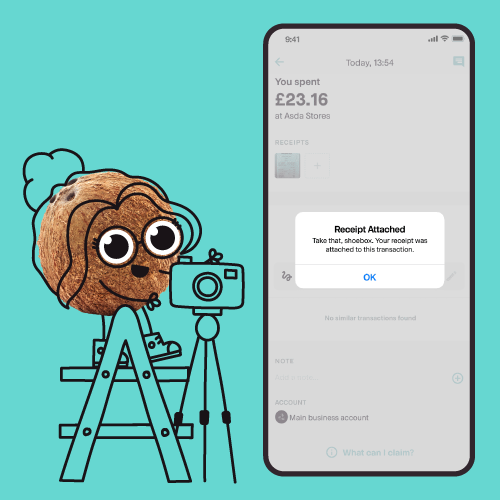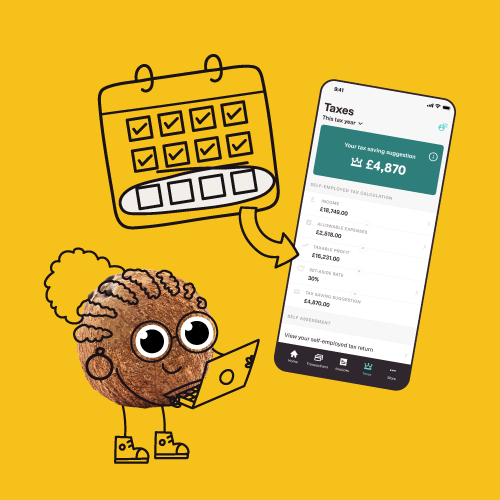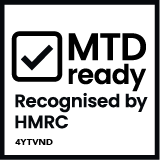New tax year. New rates. Same old question: how much tax will you owe as a sole trader? Here’s our in-depth guide.
If you're self-employed, it pays to stay on top of changing thresholds and tax bands – because understanding what you owe, and why, means no nasty surprises come Self Assessment time. In this guide, we break down:
- Income Tax
- Allowances
- National Insurance
- VAT Rates
- Payments on account
How much can you earn tax-free when you’re self-employed?
Personal Allowance
Everyone – employed or self-employed – has a Personal Allowance that resets at the beginning of each tax year. This is the amount that you can earn tax-free.
The Personal Allowance for self-employed people in 2025/26 is the same as it was in the last tax year – you will only pay tax on anything above the £12,570 Personal Allowance threshold.
As you will see in the table, the amount of Personal Allowance you have changes based on how much you earn, and reduces once you earn more than £100,000. Here are a few examples to show you how this works in practice:
- If you earn £18,000 in the tax year, you will have the full self-employed Personal Allowance, meaning you will only be taxed on any income over £12,570.
£18,000-£12,570 = £5,430 - If you earn £110,000 in the tax year, your Personal Allowance will be reduced by £5,000 (£1 per every £2 over £100,000) to £7,570, meaning your taxable income will be £102,430.
£110,000-£7,570 = £102,430 - If you earn £150,000 in the tax year, you will no longer have any Personal Allowance, meaning your whole income will be taxed.
£150,000-0 = £150,000
Trading income allowance
Another self-employed tax allowance to be aware of is the trading allowance. This is £1,000 per tax year that you can use against any income made from self-employment – and the good news is that it can be used as well as your Personal Allowance.
This is particularly useful if you are employed but have made some additional self-employed earnings (e.g. through a side hustle).
If you earn less than £1,000 in self-employed income, you don't even have to register as self-employed, and don't need to do a tax return. If you earn more than £1,000, you will have to do both of those things – but you can use the trading allowance to deduct £1,000 from your income.
If you do choose to leverage your trading allowance, do note that you will then be unable to claim any other expenses. So, if your self-employed expenses end up totalling more than £1,000 at the end of the tax year, you’re better off claiming those instead.
Self-employed income tax rates for 2025/26
For sole traders based in England, Wales or Northern Ireland, all income that you earn over and above your Personal Allowance will be taxed as follows:
If you live in Scotland, different income tax rates apply:
National Insurance rates 2025/26
As a sole trader, in addition to income tax, you will also need to pay National Insurance Contributions to HMRC. The amount you need to pay depends on your profits (your income minus your allowable expenses). There are two forms of National Insurance to be aware of as a sole trader: Class 2 and Class 4. Class 2 contributions are no longer automatically payable if your annual profits exceed £6,845, and you will instead receive a National Insurance credit that counts towards benefits such as the State Pension, even though no payment is required. If your profits fall below this threshold, you can still make voluntary Class 2 contributions, which are set at £3.50 per week, to maintain your National Insurance record.
However, Class 4 contributions are still mandatory and are calculated as a percentage of your annual profits. You can find the most up-to-date rates in the following table:
Class 4:
Payments on account
One point worth noting is that you may need to make advance payments towards your tax bill when it comes to your Self Assessment for 2024/25 – these are known as payments on account and are made twice a year: on 31st January and 31st July.
Each payment is half of your liability from last year’s tax bill. If this is your first year as a sole trader, it is unlikely you will have made payments on account before. So, for those of you completing your tax return for the first time, it would look a little like this:
Say you’re preparing your Self Assessment tax return for the 2024/25 tax year. You’ve worked as a sole trader for the full tax year and have no other sources of income. After all calculations are considered, your tax bill comes to £5,000.
Your payments to HMRC will then be broken out as follows:
- Self Assessment 2024/25 balancing payment: £5,000 – due 31st January 2026
- 1st payment on account for 2025/26: £2,500 – due 31st January 2026
- 2nd payment on account for 2025/26: £2,500 – due 31st July 2026
So that means that on 31st January 2026, rather than just paying the £5,000 you owe for 2024/25, you will be asked for an additional £2,500 as an advance on next year’s tax bill.
However, you won't need to make these payments if:
- Your last Self Assessment tax bill was below £1,000
- You’ve paid more than 80% of the tax you owe, for example through your tax code
Value Added Tax (VAT) rates
Once the annual revenue of your company reaches £90,000 within a one-year period, you will need to register for Value Added Tax (VAT): a tax paid on most goods and services.
Once you’ve registered, you will then need to start charging VAT on your sales, but you can also reclaim VAT on purchases.
Should you become VAT-registered?
If you’re under the VAT threshold, deciding whether to become VAT-registered requires a bit of thought, as you must decide whether to increase your price to charge the VAT onto your customers, or keep the prices the same and pay the VAT yourself – thus reducing your profits.
If your customers are businesses and mainly VAT-registered, it’s easier to charge them VAT, because they’re likely to be able to claim it back. But if your customers aren’t businesses and aren’t VAT registered, the increase in price could have a negative impact on your sales.
Managing VAT is where it can start to get slightly complicated as there are a few different rates and VAT schemes to be aware of. It requires careful record-keeping of all transactions and the rate of VAT they were charged at.
You can find the standard VAT rates outlined below:
Easily stay on top of your taxes
So, there we have it! A summary of the tax rates for sole traders in the 2025/26 tax year.
With so many things to consider, keeping on top of how much tax you will owe when you’re self-employed can be tricky – especially when your income can fluctuate from month to month.
But by using Coconut’s smart tax app to manage your finances, you can easily track all your income and outgoings throughout the year, meaning you will always know how much to set aside for tax. So, you will be well-prepared for your tax returns, and never be caught out by a surprise tax bill!
Try Coconut free for 30 days, no card details required – it’ll revolutionise your finances.











